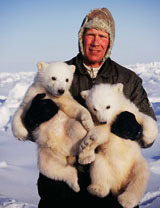 |
Dr. Steven C. AmstrupChief scientist for Polar Bears International Why should we care about polar bears? The polar bear is the world’s largest non-aquatic carnivore. It is the most mobile of all four-legged creatures, with activity areas larger than Montana. Polar bears hunt marine mammals from the surface of the sea ice. When ice-absence means they are unable to feed, they can endure a more prolonged fast than any other large mammal. But, there is a limit to how long they can be food deprived, and global warming-induced sea ice declines have been linked to reduced body condition, poorer survival, and declining abundance. Their dependence on habitat that melts as temperature rises, makes polar bears the best early indicator of threats to the Arctic from anthropogenic global warming. More importantly, they are sentinels of global health, providing advanced warning of challenges coming to all of the species and environments about which we care. Prompt and aggressive greenhouse gas mitigation still can save polar bears over much of their range. We should care about polar bears because if we act in time to save them, we also will save most of the rest of life on earth, and maximize opportunity to leave our children a world similar to that in which humans About the Lecturer Dr. Steven C. Amstrup is Chief scientist for Polar Bears International. He also is an adjunct professor at the University of Wyoming in Laramie. He earned a B.S. in Forestry from the University of Washington (1972), a M.S. in Wildlife Management from the University of Idaho (1975), and a Ph.D. in Wildlife Management from the University of Alaska Fairbanks (1995). Prior to joining PBI, he led polar bear ecology research in Alaska for 30 years. He is a past chairman of the IUCN Polar Bear Specialist Group and has been an active member of the group for 32 years. Dr. Amstrup has authored or coauthored over 130 peer-reviewed articles on movements, distribution and population dynamics of large mammals. He is the senior editor of a recent text on population estimation methods. In 2007, he led a USGS research team in production of 9 reports that were instrumental in convincing the US Secretary of Interior polar bears should be declared threatened. More recently Dr. Amstrup led an effort showing polar bears are not unavoidably doomed. In the December 2010 issue of Nature, he and his coauthors showed that preserving polar bears is all about controlling man-caused temperature rise. In 2012, Amstrup was selected as recipient of the Indianapolis Prize, and a Bambi Award for his efforts in animal conservation. Steven C. Amstrup led polar bear research efforts for the U.S. federal government for 30 years. During that time, he successfully fought to maintain long-term collection of data necessary to assess population trends and understand changes over time. Dr. Amstrup has authored or coauthored more than 130 scientific papers, most covering major aspects of polar bear ecology. His papers have received quality awards from the Wildlife Society and provide essential information for conservation and management. Much of what we now know about polar bears, and the threats they now face, we know because of Amstrup’s long-term and pioneering research. Amstrup was the first to successfully use radio telemetry to follow the movements of polar bears. The methods he developed in the 1980’s have been emulated by other polar bear researchers and are now being used around the world. He solved the decades old mystery of where Alaskan polar bears go to give birth to their young. Through continued monitoring, he has shown that deteriorating sea ice is now altering historical patterns. Amstrup’s long-term database now provides the insights necessary to understand the future challenges polar bears face because of global warming. In 2007, Amstrup led an international team of scientists in efforts to assess the likely future impacts of global warming on polar bears. Those efforts culminated in the projection that 2/3 of the world’s polar bears could disappear by midcentury, and all could be lost by the end of the century, if greenhouse gas emissions continue on the present course. Based principally on those findings, the U.S. Secretary of Interior listed polar bears as a threatened species under the Endangered Species Act. The dire 2007 polar bear projections, along with fear that the Arctic sea ice was about to disappear beyond an irreversible tipping point, led many to believe nothing could be done to save polar bears from extinction. Amstrup assembled a research team to test that hypothesis, and to examine whether greenhouse gas mitigation could improve the future outlook. That work, published in the journal Nature, demonstrated that there are not tipping points in the summer sea ice, and confirmed that the key to preserving polar bears is reducing temperature rise through greenhouse gas mitigation. The mitigation efforts Amstrup proposes to save polar bears will benefit all species worldwide, including humans. Recognizing that there is no future for polar bears without greenhouse gas mitigation, Amstrup retired from the U.S. Geological Survey and became the chief scientist with the nonprofit Polar Bears International. There, he can speak openly about what needs to be done. His mission at PBI is to use the wisdom garnered during his 30 years of polar bear studies to stimulate actions necessary to save the climate in which polar bears, and the rest of life on earth as we know it, have flourished. |
|
